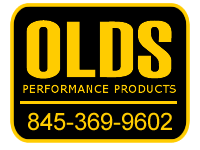Oldsmobile big blocks, unlike the Chevrolets have over 13 feet of bearing material that needs to be covered at all times. Modifications to even a stock rebuild will ensure that your engine is mechanically stable under any type of situation. It is important to understand that oil is not only a means to lubricate the engine components but it is also a means to keep those engine components cool. Keeping the engine components cool is done by allowing the oil to flow through those clearances at a rapid pace with no restrictions what so ever. It is also important to understand, what goes up must come down. Oil is pushed through force by the oil pump resulting in pressure which feeds oil first through the oil filter and then back into the block towards the main bearings, rod bearings as well as filling the two oil gallerys that individual feed each lifter bore, up through the lifters and out the pushrods which oil the springs and rocker arms. It is important to have an oil filter that first and foremost will allow oil to pass through its element without restriction, yet still catch particles of debris if necessary. Buyer beware, not necessarily is the brands of filters that you see advertised the best for your engine. Results have actually shown that the oil filters advertised the most are actually the ones that have been sighted often for their inconsistencies in the construction of their paper element inside, inconsistencies that can leed to blockage or the restriction of oil which prohibits pressure and flow. I am not to fond of the color orange if you know what I mean. Bearing clearances are the most important part of the engine. How there set will determine the life expectancy of your engine. I have never seen an engine fail with clearances that are looser than what these factory manuals and other manuals written by uneducated authors illustrate. The authors probably never have seen the insides of an engine in their life, let alone speak about what is correct and what is incorrect for an Oldsmobile performance engine. You can view my specification guide to clearances in the tech article section which will be coming soon. The correct clearances will allow oil to flow rapidly through the bearings acting as a cooling agent and protecting those internal parts. Engine Bearing clearances that are too tight are a recipe for disaster and engine bearing clearances that are too tight combined with heavy weight viscosity oils such as a 20 50 is even worse. Pressure is not where it is at people, it is volume. Do not be so caught up in pressure. Pressure is a measurement of restriction combined with force. High pressures dictate a restriction and that is not what you want. You want your oil pressure gauge to be responsive as your engines rpms increase. You want that oil pressure gauge to sweep and respond with engine rpm. Just to give you a for instance, an NHRA pro stock engine that is 500 cubic inches and produces in excess of 1300 hp and 800 plus foot pounds of torque, idles with oil pressures between 8 and 12 psi and when it reaches its maximum rpm which is about 9600 it only achieves 48 to 52 pounds of oil pressure. These are high rpm, high load and high stress racing engines and they must perform with out failure time and time again. What goes up must come down. This is one of the largest faults or inherent problems with an Olds engine, oil restrictions which do not permit oil to flow freely down from the heads to the pan fast enough. Modifications must be made to enlarge the four oil passage areas in the block where the oil travels down through the head gaskets and down the back and front of the block in the lifter valley area. These 4 small holes are part of the deck surface area on most big block Olds engines. I would recommend to actually carve them clean out of the block and polish that area. I also enlarge the front and back drain holes in the heads as well. I do recommend an oil viscosity that will flow well through the bearing clearances and allow for good drain back. A 10 30 for the cooler months and a maximum viscosity of a 10 40 for the hotter summer months.
